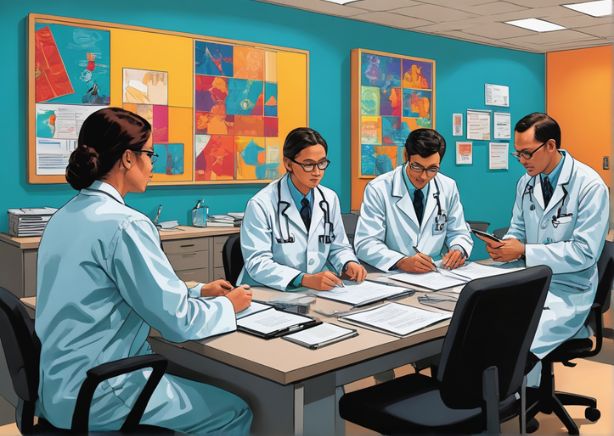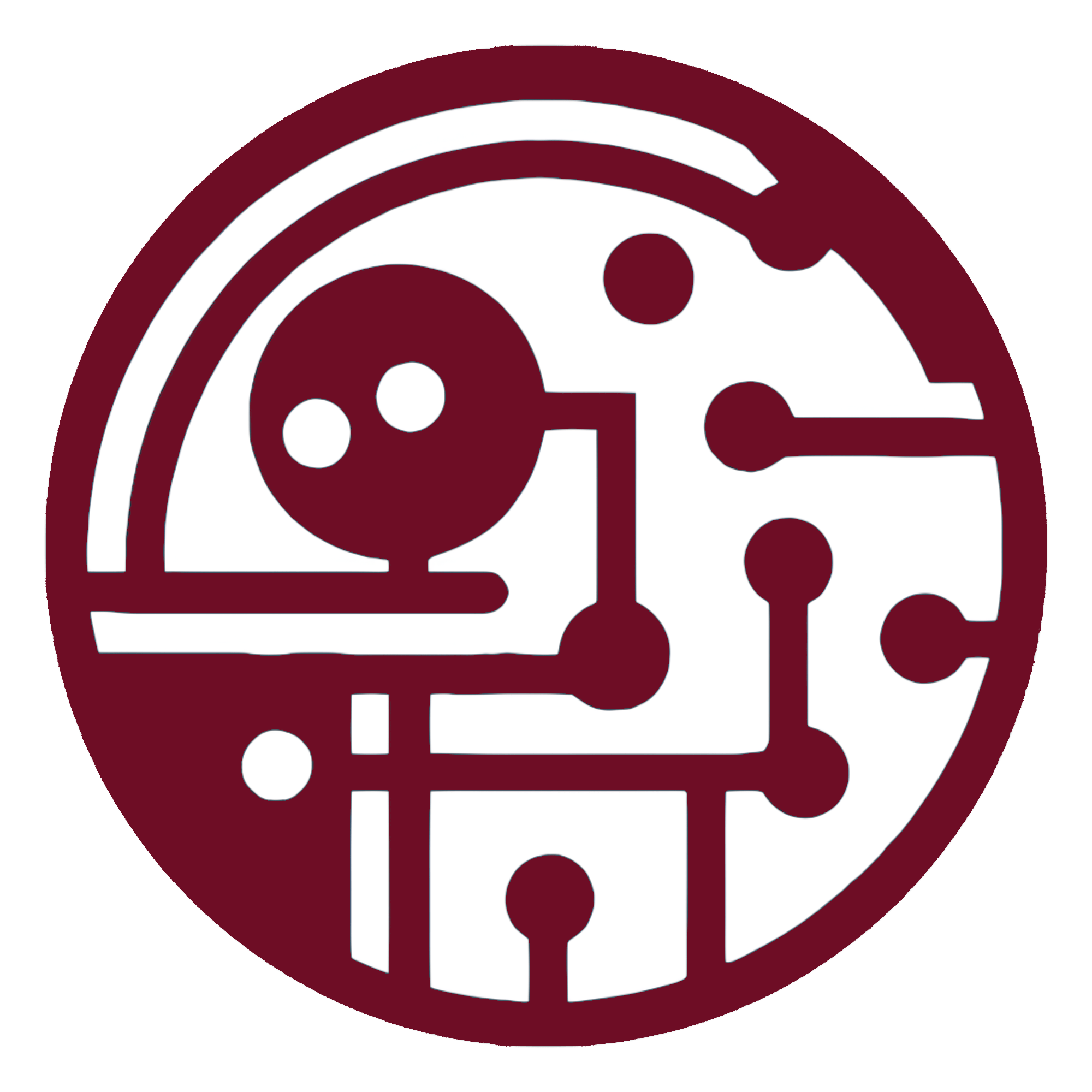Interprofessional Education:
Strengthening Collaboration between Healthcare Professionals in Medical Education

In the current health context, where interdisciplinarity becomes increasingly relevant, interprofessional education emerges as a strategic pillar in the training of professionals capable of effective collaborative work. This article explores the importance of interprofessional education in strengthening collaboration between healthcare professionals, a pressing need in 21st century medical education.
A interprofessional education - IPE, by integrating students from different areas of health into a common learning environment, provides a rich exchange of knowledge and experiences. This process not only reinforces the specific skills of each profession, but also develops fundamental communication and teamwork skills, essential for the integrated treatment of patients.
Considering the contemporary healthcare scenario, marked by complexities and emerging challenges, the ability to work collaboratively becomes indispensable. Well-educated healthcare professionals in this model are better able to face such challenges effectively, promoting notable improvements in the quality of patient care.
The practice of interprofessional education also offers a conducive environment for understanding the diverse cultures and practices that make up the health field. Exposure to different perspectives and treatment methods enriches students' learning and prepares them for more inclusive and respectful clinical practice.
In practical terms, implementing IPE programs into academic curricula requires collaboration between faculties and departments. Establishing common learning spaces, where students of medicine, nursing, pharmacy, among others, can learn together, is fundamental to the success of this educational enterprise.
Additionally, leadership at educational institutions plays an important role in promoting and supporting the interprofessional education initiative. Adherence to the IPE model should be encouraged through institutional policies that recognize and encourage interdisciplinary collaboration as standard practice.
The challenges to the effective implementation of IPE are intense, including resistance to changing traditional educational paradigms and the need to invest in adequate resources. However, the benefits of training healthcare professionals who can collaborate efficiently outweigh these obstacles.
For interprofessional education to reach its full potential, it is essential that there is a continuous commitment with the evaluation and improvement of programs. This includes conducting research that can concretely demonstrate the benefits of this approach, both for healthcare professionals and patients.
When considering the future of health education, we invite professionals and institutions to reflect on the importance of interprofessional education. To find out more about How your institution can implement or improve IPE programs, proceed to the next section of this article, where we will discuss effective strategies for integrating this model into healthcare curricula.
Discover how Interprofessional Education is revolutionizing medical education! Our new paper explores the importance of this collaborative approach that unites diverse healthcare disciplines, preparing professionals to face the complex challenges of patient care in the 21st century. Dig deeper into the benefits, challenges, and strategies for effectively implementing IPE in medical education curricula. Don't miss valuable tips on how we can transform education and improve health systems.
Click to read more and join the conversation about healthcare innovation!

Interprofessional Education: An Overview
Interprofessional education (IPE) is defined as a teaching approach that brings together students from different health disciplines to learn together during a certain period of their educational training. This interaction aims to prepare future professionals for a collaborative practice, where communication and mutual understanding are fundamental to the provision of high-quality healthcare.
Interprofessional education represents an evolution in the field of health education, bringing to light the need for a more holistic and collaborative approach to medical education. By bringing together students from diverse disciplines, such as medicine, nursing, pharmacy, and physiotherapy, among others, IPE facilitates a shared learning environment that is essential for the development of interpersonal and interdisciplinary skills.
The concept of IPE is not just about learn alongside from other future healthcare professionals, but about deeply understanding how the various functions within a healthcare system can interact to improve patient care. This approach helps break down the traditional silos that often exist between different areas of healthcare.
In addition to promoting better communication and collaboration, EIP is designed to improve understanding and mutual respect between professions. This is central, as mutual respect is the basis for an effective healthcare team, capable of dealing with complexities and emergencies with a more cohesive and coordinated dynamic.
The implementation of IPE in health education institutions occurs through educational modules that encourage collaboration and interdisciplinary discussion. Such modules are designed to expose students to real patient care situations, where collaboration between different specialists is essential.
One of the biggest advantages of this approach is the ability to adapt students to the interprofessional reality they will face in their careers. When moving from theory to practice, these professionals will already be familiar with the dynamics of working in a multidisciplinary team, which is a significant competitive advantage.
IPE also plays a vital role in preparing students to face ethical and practical challenges in the healthcare environment. By understanding the capabilities and limitations of other specialties, future professionals can better navigate the complexities of patient care.
However, for interprofessional education to be effectively integrated into health curricula, it is necessary to commitment of educational leaders and adapting infrastructures to support this type of collaborative learning. Investment in educational resources and training qualified teachers to conduct these programs are essential.
To continue exploring how IPE can be effectively implemented at your institution, continue to the next section where we will cover practical strategies and examples successful integration of interprofessional education into health curricula.

Benefits of Interprofessional Education
The benefits of interprofessional education - IPE are documented in numerous research studies that demonstrate how this approach not only improves patient health outcomes but also optimizes healthcare system resources. Effective collaboration can reduce medical errors, increase job satisfaction, and promote more respectful and productive work environments.
Interprofessional education offers numerous benefits for both healthcare professionals and patients, and these benefits are widely supported by academic research. By fostering a culture of collaboration, IPE improves the quality of patient care, demonstrating a significant reduction in the incidence of medical errors.
Medical errors are one of the main causes of mortality in hospital settings. Effective collaboration, fostered by IPE, contributes to better communication between professionals from different areas, allowing a more holistic and careful approach to treating patients, which directly reduces the likelihood of care failures.
Another important aspect is the optimization of health system resources. With the implementation of IPE, teams learn to better use available resources, maximizing the effectiveness of treatments and avoiding waste of materials and human efforts. This translates into more sustainable and efficient healthcare systems.
Job satisfaction is significantly higher in environments where interprofessional education is a common practice. Healthcare professionals who understand and value the roles of their colleagues tend to experience greater job satisfaction, which can lead to a lower turnover rate and greater dedication to the patient.
Interprofessional collaboration also contributes to more respectful work environments. When healthcare professionals are trained to work together from the beginning of their training, they develop a deeper mutual respect, which promotes a culture of mutual support and respect for different skills and specializations.
Furthermore, the implementation of IPE in educational institutions and health systems promotes innovation. Professionals trained in an interprofessional environment are more likely to develop new solutions and approaches to patient care challenges as they learn to think outside the traditional boundaries of their own specialties.
These professionals are also better equipped to lead changes in healthcare systems because they understand how different parts of the system interact. This is essential for leading healthcare reforms that require a cohesive and integrated approach.
In short, IPE is not just beneficial, it is transformative. When considering the significant advances it promotes, it is essential that institutions and health professionals actively engage in its implementation. Continue reading in the next section, where we will explore specific challenges and how to overcome them to effectively integrate IPE into healthcare curricula and practices.

Implementation in Medical Education Curricula
Incorporating Interprofessional Education (IPE) into medical education curricula requires a curricular restructuring that goes beyond isolated subjects. It involves the creation of shared modules that allow interaction between students of medicine, nursing, pharmacy, physiotherapy, among others. This is a significant challenge, but studies show it is worth the effort.
The incorporation of interprofessional education into medical education curricula is a fundamental step to adapt healthcare institutions to the contemporary needs of the sector. This integration requires an innovative and structured approach to restructuring existing curricula, aiming to promote a comprehensive and collaborative training between health professional categories.
To implement IPE, universities must first carry out a detailed assessment of current curricula, identifying opportunities for integrating shared modules. These modules should be designed so that students from different areas, such as medicine, nursing and pharmacy, can work together on projects and case studies that simulate real work situations.
Creating shared modules not only facilitates interprofessional interaction, but also promotes a deeper understanding of the various perspectives and competencies that each professional category brings to patient care. This understanding is necessary for the development of a effective collaborative practice in the healthcare environment.
In addition to theoretical modules, it is essential to incorporate practical internships where students from different areas can collaborate directly. Internships in hospitals, clinics, and communities can provide valuable experiences that reinforce collaborative learning and prepare students for real-world interdisciplinary challenges.
However, for IPE to be effectively implemented, it is also necessary to invest in teacher training that can guide and facilitate this educational approach. Educators must be trained in interprofessional teaching techniques so that they can effectively guide and assess students in a collaborative environment.
Logistical challenges, such as conflicting schedules and coordinating resources between different departments, must also be carefully managed. The leadership of institutions has a role in overcoming these obstacles, promoting a collaboration culture and resource sharing.
The benefits of implementing IPE into curricula are clear, with studies indicating significant improvements in the quality of patient care and the effectiveness of teamwork in healthcare settings. Therefore, despite the challenges, integrating IPE into medical curricula is an initiative that is worth the dedicated effort.
Adopting IPE is, therefore, an essential strategy for institutions that wish to lead in the training of health professionals ready to face the modern challenges in the area. To continue exploring how to overcome the challenges and barriers to implementing IPE, move on to the next section of this article, where we will discuss the main obstacles and how successful institutions have navigated these issues.
Challenges and Barriers
Despite its numerous benefits, the implementation of Interprofessional Education (IPE) faces significant barriers, such as resistance from colleges that are accustomed to a more flexible model. traditional education. Furthermore, the lack of resources and the need for specific training for educators These are challenges that need to be overcome for this educational approach to be effectively adopted.
The implementation of IPE in healthcare curricula faces a number of significant challenges and barriers that need to be overcome to ensure its effectiveness. One of the main obstacles is the resistance found within educational institutions themselves, where faculties are accustomed to more traditional models of education.
This resistance often manifests itself in the form of a hesitation to alter established teaching methods and rigid disciplinary curricula. Convincing departments to adopt a more collaborative approach may require a significant change in institutional culture, which is a complex and time-consuming task.
In addition to internal resistance, the lack of adequate resources is also a major challenge. The implementation of IPE requires investments in new teaching materials, teaching technologies and infrastructure to support collaborative learning, resources that are not always available in educational institutions.
Another barrier is the need for specific training for educators. To teach effectively in an interprofessional environment, teachers must be able to integrate knowledge from various disciplines and promote effective interaction between students from different areas of health.
The issue of evaluation also presents itself as a challenge. Developing assessment methods that appropriately reflect interprofessional learning and collaborative competencies is essential, but creating these methods requires a deep understanding of how interprofessional competencies can best be measured and assessed.
To deal with these barriers, it is important that institution leaders commit to the vision of interprofessional education. This commitment must be translated into clear policies, institutional support and allocation of resources necessary to facilitate this educational transition.
Furthermore, it is essential to promote dialogue and collaboration between different departments and specialties within institutions. Encouraging communication and sharing of ideas can help break down resistance and build consensus about the importance and benefits of IPE.
Despite the challenges, institutions that have overcome these barriers report notable improvements in the quality of care and job satisfaction. Therefore, overcoming these obstacles not only benefits students and professionals, but also patients who receive more coordinated and efficient care. To deepen your understanding of how these barriers were overcome and explore relevant case studies, continue to the next section of our article.

The Path Ahead
The future of Interprofessional Education (IPE) will depend on the ability of educational institutions to adapt their curricula and a committed leadership with health education reform. Interprofessional collaboration is not just a pedagogical approach, but an emerging need in the face of an increasingly complex global health scenario.
The future of IPE presents itself as a challenging but essential journey that will require a continued commitment of educational institutions and leaders in the health sector. Adapting curricula to incorporate IPE is not just an educational option, but a necessary response to the demands of a complex and ever-changing global healthcare environment.
To move forward successfully, educational institutions must first establish a clear commitment with health education reform. This involves not only reevaluating and adapting existing curricula, but also allocating sufficient resources to support the transition to interprofessional teaching practices.
Leadership within educational institutions plays a central role in this process. Leaders must be proactive in promoting the vision of interprofessional collaboration, ensuring it becomes a strategic priority within the organization. This includes providing support for teacher training and development of new teaching materials.
Furthermore, it is essential that there is closer collaboration between the different health professional categories. Fostering an environment where doctors, nurses, pharmacists, and other healthcare professionals can learn from each other and understand each other's roles is essential to the success of IPE.
The involvement of regulatory and accreditation bodies is also essential. These entities must recognize and encourage interprofessional education as part of the accreditation criteria for health programs, which can boost the adoption of these practices by more institutions.
It is equally important to measure the impact of IPE through ongoing research. To assess How IPE affects the quality of care patient, healthcare team effectiveness, and health outcomes can provide valuable data to further improve curricula and teaching practices.
Continuous dialogue with existing healthcare professionals, who can offer valuable insights into how to best integrate interprofessional theory with clinical practice, is also important. This interaction can help ensure that interprofessional education remains relevant and aligned with practical needs from Camp.
Ultimately, the path forward for interprofessional education requires a multifaceted and collaborative approach, involving educators, healthcare professionals, regulators, and institutional leaders. To explore more about how each of these actors contributes to advancing IPE and how they can work together to overcome challenges, continue reading in the next section of this article.

Conclusion
Interprofessional Education (IPE) is more than a pedagogical strategy; It is a strategic imperative to strengthen interprofessional collaboration that sustains the quality of health care. This article highlights the importance of integrating Interprofessional Education effectively into medical training curricula, thus preparing healthcare professionals for the challenges of the future. We invite readers to reflect on the necessary changes and act towards an educational transformation that prioritizes collaboration and efficiency in patient care.
IPE transcends the mere incorporation of new teaching techniques into medical curricula; she represents a essential paradigmatic change for the future of global health. This article discussed how IPE can strengthen collaboration between healthcare professionals, improving the quality and effectiveness of care provided to patients.
Revisiting the key points, we saw that IPE promotes better communication and mutual understanding between different healthcare professionals, which is central to the efficient management of complex cases in clinical settings. Furthermore, the ability to work cohesively as an interdisciplinary team reduces medical errors and increases job satisfaction.
The implementation of IPE in teaching curricula undoubtedly faces significant challenges, including the resistance of traditional educational structures and the need for additional resources. However, the advantages of overcoming these obstacles are clear, not only for the effectiveness of the health system, but also for the preparation of professionals capable of facing the future demands of the sector.
Educational leadership and administration of healthcare institutions play important roles in promoting and implementing IPE. It is necessary for these leaders to adopt a progressive vision, recognizing the strategic importance of interprofessional education in advancing global health.
Continued dialogue between educational institutions, regulatory bodies, and healthcare professionals is vital to constantly adjust and improve IPE programs. Collaboration between these entities can ensure that IPE programs are not only implemented, but also continually reviewed and improved.
Measuring the impact of IPE on the quality of patient care and the efficiency of healthcare teams is critical to justify continued investment in this educational approach. Studies and research should be encouraged to provide concrete data to support the expansion of IPE.
As healthcare professionals or educators, it is essential to question and reflect on how we can contribute to the implementation and success of interprofessional education. The necessary transformation in medical education requires a change in mindset that prioritizes collaboration, communication and mutual respect.
In conclusion, interprofessional education is not just beneficial, it is essential. We encourage all readers to reflect on how they can positively influence the implementation of IPE in their own institutions. If you have experiences or ideas on this topic, please share them with us by sending a message. Your contribution is necessary to enrich the discussion and promote effective changes in medical education.
This article serves as an informative and provocative resource, offering a concrete basis for exploration and deepening the topic of interprofessional education, essential for the evolution of medical education and collaborative clinical practice.
How about sharing this story with your colleagues?
Together, we can inspire positive change in medical education, shaping future healthcare professionals who are more prepared and connected to the needs of the 21st Century.
Share now and be part of this transformation!
Common questions
A interprofessional education in health fundamentally aims to prepare students and professionals from different areas of health to work collaboratively, with the aim of offering integrated, high-quality care to patients. By learning together, doctors, nurses, pharmacists, and other healthcare professionals develop a mutual understanding of their respective roles and competencies, which is essential for efficient and safe practice.
The focus of this educational approach is on improving communication and coordination between different specialties, which can significantly reduce medical errors and increase the effectiveness of the treatment provided. Incorporating principles of healthcare collaboration, The interprofessional education contributes to building more resilient and adaptive teams, ready to face the complex challenges of the contemporary healthcare sector.
Furthermore, the effective implementation of interprofessional education results in measurable benefits for both healthcare professionals and patients, generating a more respectful work environment and a more satisfying patient care experience. These are fundamental reasons that justify the adoption of this educational modality in the curricula of institutions focused on health.
For more information about how interprofessional education is being implemented globally, visit the World Health Organization (WHO) website which offers up-to-date resources and guidelines: www.who.int.
The difference between the approaches multi-professional It is interprofessional in healthcare is fundamental to understanding how care is organized and delivered. The multidisciplinary approach involves several health professionals working independently, each contributing their specialty to patient care, but without necessarily interacting or collaborating intensively with each other.
On the other hand, the interprofessional education promotes a much more active and collaborative integration between different health professions. In this approach, professionals learn together from training and continue to work as a team in a coordinated and cooperative manner, focusing on a common goal of patient care. This collaboration is designed to increase treatment efficiency and improve health outcomes by integrating each professional's skills cohesively.
Interprofessional education is, therefore, more comprehensive and engaging, seeking to break down barriers between professions and foster a truly collaborative work environment. This approach has shown significant results in improving communication between healthcare professionals and reducing clinical errors, directly benefiting the quality of patient care.
To deepen your understanding of interprofessional practices and how they differ from multiprofessional practices, it is recommended to visit the Interprofessional Education Collaborative page, which offers relevant resources and case studies: www.ipecollaborative.org.
One interprofessional team in the health sector is a group of professionals from different professional categories who work together in a coordinated way to provide comprehensive and integrated care to patients. This team is made up of doctors, nurses, pharmacists, physiotherapists, social workers, among others, who share information and responsibilities to optimize treatment and improve health outcomes.
The key concept of this approach is the active collaboration, where each member contributes their specific expertise, while learning from the skills of other team members. This allows staff to address patients' needs holistically, considering multiple aspects of health and wellbeing in their decisions and interventions.
The success of an interprofessional team depends on effective communication and mutual respect among members, as well as the ability to integrate different care plans into a cohesive strategy. This approach has proven efficient in improving patient satisfaction and reducing costs by preventing complications and hospital readmissions.
For more information about how to form or improve interprofessional teams in medical practice, visit the Agency for Healthcare Research and Quality website, which offers guidelines and educational resources: www.ahrq.gov.
A interprofessional approach It is a collaborative method in teaching and in healthcare practice that focuses on the integration of different professions within patient care. This strategy brings together professionals from different areas, such as doctors, nurses, psychologists and pharmacists, to learn and work together, aiming to optimize health outcomes through a more complete understanding of the various facets of patient care.
Essentially, the interprofessional approach promotes a culture of mutual respect and understanding between professional categories, allowing healthcare professionals to collaborate more effectively. This is accomplished through shared education and clinical practices where the knowledge and skills of each professional are valued, leading to a more holistic and integrated view of patient care.
The main benefit of this approach is the significant improvement in quality of care provided, as effective collaboration can help prevent errors, reduce treatment costs and increase patient and professional satisfaction. The integration of different professional perspectives facilitates more comprehensive treatment adapted to the individual needs of patients.
To explore more about implementing the interprofessional approach and its benefits, visit the Interprofessional Education Collaborative website, which offers educational resources and practical guidelines: www.ipecollaborative.org.
A interprofessional collaboration refers to the process of different healthcare professionals working together in a coordinated manner to improve patient health outcomes. This collaboration involves effective communication and knowledge sharing between doctors, nurses, pharmacists, physiotherapists, social workers and other specialists, with the aim of providing a more comprehensive and effective care.
This practice is important for treating patients with complex conditions, where expertise from multiple disciplines is required for a successful care plan. Interprofessional collaboration not only improves the safety and quality of patient care, but also increases job satisfaction among healthcare professionals, as it promotes an environment of mutual support and continuous learning.
The success of interprofessional collaboration depends on an organizational culture that values and supports communication and respect between different disciplines. Training and professional development programs continuous training are essential to equip professionals with the skills needed to work effectively in interdisciplinary teams.
For more information about how to promote and implement interprofessional collaboration in healthcare practices, visit the World Health Organization (WHO) website, which offers guidelines and educational resources on the topic: www.who.int.
Form and maintain a interprofessional team Effective implementation presents several challenges that need to be managed carefully. One of the main ones is effective communication between professionals with different backgrounds and specific vocabularies in their areas. Lack of clear communication can lead to misunderstandings and errors in treating patients.
Another significant challenge is resistance to change in established practices. Many professionals are used to working independently and may see interprofessional collaboration as a threat to their professional autonomy. Overcoming these cultural barriers and promoting true interdisciplinary integration requires strong leadership, adequate training, and an ongoing commitment to teamwork principles.
Additionally, allocating resources to support interprofessional teams can be challenging, especially in health systems with limited budgets. Adequate equipment, collaborative workspaces, and time for meetings and coordination are essential to the success of such teams.
For more information on how to overcome these challenges and promote effective interprofessional collaboration, check out the resources available on the Agency for Healthcare Research and Quality website, which offers guides and case studies on the topic: www.ahrq.gov.
Interprofessional training is central to teamwork in the Unified Health System (SUS), as it prepares professionals from different areas of health to collaborate effectively. This approach is fundamental in improving the quality of patient care, as it allows for a more holistic and integrated view of care, essential in a public health system as comprehensive as the SUS.
Through interprofessional education, professionals learn to value and understand roles and competencies each other, which is essential for the effective and efficient coordination of health services. This mutual understanding is especially important in a complex system like the SUS, where collaboration can mean the difference between fragmented care and cohesive, continuous care.
Furthermore, interprofessional training helps to overcome institutional and personal barriers that may impede effective cooperation between different specialists. By promoting a culture of respect and cooperation, the SUS can improve not only health outcomes for patients, but also the satisfaction and efficiency of healthcare professionals.
To understand more about how interprofessional training is being applied in the SUS and its impact on patient care, visit the Ministry of Health website, which offers detailed guidelines and reports on education policies and health practices: www.saude.gov.br.
A interprofessional education and collaborative practice involve training and cooperation between different health professionals to improve teamwork and the integrality of actions in health systems. These practices are designed for doctors, nurses, pharmacists, and other professionals to learn together and better understand each other's roles, fostering a more integrated and efficient approach to patient care.
Implementing interprofessional education within existing healthcare systems promotes greater coordination between different specialties, which is essential to effectively respond to patients' complex needs. This approach significantly improves the quality of care, reducing errors, optimizing resources and ensuring a faster and more effective response to healthcare interventions.
Furthermore, collaborative practice strengthens the health system by improving communication between professionals, which increases job satisfaction and reduces the incidence of burnout among teams. By working together, professionals can share responsibilities and support each other, improving the work environment and the effectiveness of the services provided.
For more information about how interprofessional education and collaborative practice are being integrated to improve health systems, visit the World Health Organization website, which offers global resources and guidelines on the topic: www.who.int.
A interprofessionality in health refers to the process of collaboration and joint learning between different healthcare professionals, such as doctors, nurses, pharmacists and other specialists. The objective of this approach is integrate diverse professional skills to offer more comprehensive and efficient care to patients, improving communication and coordination between teams.
In practice, interprofessionality allows healthcare professionals to better understand each other's roles and responsibilities, which facilitates more informed and coordinated decision-making. This integration is important to face complex challenges in patient care, especially in cases that require a multidisciplinary approach for diagnosis and treatment.
In addition to improving the quality of care, interprofessionality promotes a more collaborative work environment that is less susceptible to conflicts, contributing to professional satisfaction and the overall efficiency of the health system. This cooperation is a direct response to growing demands for a more holistic, patient-centered healthcare system.
To explore more about the implementation and benefits of interprofessionality in healthcare, the World Health Organization offers a series of resources and guidelines that can be accessed through its official website: www.who.int.
A interprofessionality It is essential to the contemporary healthcare system as it facilitates effective collaboration between different healthcare professionals. This approach promotes understanding and mutual respect between professional categories, which is essential to provide holistic and coordinated healthcare to patients. By integrating skills from multiple specialties, professionals can offer more complete and efficient treatment.
In addition to improving the quality of patient care, interprofessionality also contributes to optimizing resources within healthcare institutions. Working as a team reduces redundancies and improves operational efficiency, which is necessary in an environment where resources are often limited. Professionals who collaborate effectively are able to share responsibilities and make more informed decisions, which decreases the likelihood of medical errors.
In medical education, interprofessionality is equally important, as it prepares future health professionals to work in collaborative environments. Teaching students from different areas of healthcare to work together from an early age fosters a team culture that lasts throughout their career, positively impacting patient care.
For more details on how interprofessionality is applied in practice and its impact on health outcomes, visit the Interprofessional Education Collaborative website, which offers case studies and educational resources: www.ipecollaborative.org.
A interprofessional practice refers to the collaborative process in which members of various healthcare professions work together to provide optimal care to patients. This practice is based on the idea that collaboration between different specialists can result in a more integrated and effective care approach, significantly benefiting patients' health.
In interprofessional practice, professionals such as doctors, nurses, physiotherapists, social workers and pharmacists share their expertise and points of view, creating a more comprehensive treatment plan. This integration helps ensure that all aspects of the patient's health are considered, providing more efficient treatment with better results.
Essentially, interprofessional practice is a central part of modernization of health services, promoting effective communication and joint decision-making. This cooperation not only improves the quality of care, but also increases the satisfaction of the professionals involved and reduces costs by preventing redundancies and errors.
To deepen your understanding of how interprofessional practice is being implemented in different health systems and the results achieved, visit the World Health Organization (WHO) website, which offers detailed resources and global guidelines on the topic: www.who.int.
A interdisciplinarity refers to the integration of knowledge from different academic disciplines to explore new perspectives and solve complex problems more effectively. Already the interprofessionality is applied specifically in the healthcare context and involves collaboration between professionals from different areas of healthcare, such as doctors, nurses and pharmacists, working together to offer more integrated and efficient care to patients.
While interdisciplinarity seeks Cross academic boundaries to create new forms of knowledge and solutions, interprofessionality focuses on improving health outcomes through a collaborative practice. Both are essential for promoting a holistic and innovative approach in their respective fields, allowing experts to combine their skills and knowledge to achieve common goals.
These concepts are fundamental to advancing treatment and health research, ensuring that patient care is approached in a comprehensive and cohesive manner. Collaboration between different professionals promotes a broader understanding of patient needs, which results in more effective and personalized healthcare.
For more information about how interdisciplinarity and interprofessionality are transforming fields such as healthcare, education, and other areas, visit the National Academies of Sciences, Engineering, and Medicine website, which offers resources and reports on these practices: www.nationalacademies.org.
A Interprofessional Communication is an important element in collaboration between different health professionals, aiming to optimize patient care. This form of communication involves clear and effective sharing of information among doctors, nurses, pharmacists, physiotherapists and other health specialists. The goal is to ensure that all team members have a complete understanding of the patient's treatment plans, diagnoses, and needs.
This efficient communication not only facilitates coordination between different disciplines, but also increases patient safety by reducing the risk of errors and omissions in care. When promoting a open and respectful exchange of information, interprofessional communication helps build a more cohesive and efficient team, capable of responding more quickly and effectively to the complexities of modern healthcare.
Furthermore, interprofessional communication is essential for the ongoing education and training of healthcare professionals. Through it, knowledge and experiences are shared, contributing to the continuous professional development of everyone involved and to the continuous improvement of the quality of patient care.
For more details on best practices and the importance of interprofessional communication, visit the Joint Commission website, which offers detailed guidelines and educational resources on this topic: www.jointcommission.org.
The expression interprofessional team or multidisciplinary refers to a group of professionals from different specialties who work together to provide a holistic, integrated approach to patient care. The main goal of these teams is to combine the skills and knowledge of multiple disciplines to improve health outcomes, ensuring that all aspects of a patient's well-being are considered in the treatment plan.
Interprofessional or multidisciplinary teams are particularly important in complex care settings, such as in intensive care, oncology, and mental health units, where patients' needs are often multifaceted and require coordinated interventions from different healthcare professionals. Working as a team allows for a more effective and personalized response, minimizing risks and maximizing treatment efficiency.
In addition to improving the quality of care, the formation of interprofessional or multidisciplinary teams also promotes a more collaborative and educational work environment, where members can learn from each other and develop their professional skills on an ongoing basis. This not only benefits patients, but also enriches the experience and knowledge of the professionals involved.
For more information about how interprofessional and multidisciplinary teams are formed and operate, visit the World Health Organization (WHO) website, which offers educational resources and guides on managing healthcare teams: www.who.int.
One multidisciplinary team in the health sector is made up of professionals from different specialties who collaborate to provide comprehensive care to the patient. Among the typical professions that are part of this team are doctors, nurses, pharmacists, physiotherapists, psychologists, social workers, and nutritionists. Each member brings their specific expertise, contributing to a holistic and effective treatment plan.
In addition to these, depending on the patient's needs, the team may include other specialists such as occupational therapists, speech therapists, dentists and technicians in various areas of health. The integration of professionals from various professional categories allows care to be personalized and adjusted to the specific needs of each patient, which is important for complex and chronic treatments.
Effective collaboration between these professionals is essential to ensure that all aspects of the patient's health are considered, maximizing the quality of care and improving clinical outcomes. Each professional contributes their unique perspective, enriching the decisions made and offering more complete support to the patient and their family.
For more information about the role of each professional within a multidisciplinary team and how this collaboration works in practice, visit the American Health Information Management Association website, which offers in-depth resources on managing healthcare teams: www.ahima.org.
One multidisciplinary team in the health sector consists of a group of professionals from different specialties who collaborate to offer integrated and efficient treatment to patients. This team may include doctors, nurses, pharmacists, psychologists, physical therapists, and other specialists necessary to address all dimensions of the patient's health.
The main objective of a multidisciplinary team is to ensure that patient care is holistic, encompassing not only medical treatment, but also emotional, social and physical support. Each professional contributes their specific expertise, allowing for a more complete care approach that meets the patient's diverse needs.
Working in a multidisciplinary team also promotes better communication and understanding between different fields of healthcare, which is necessary for coordinating a cohesive treatment plan and increasing the effectiveness of the care provided. This improves outcomes for patients and increases satisfaction for both patients and professionals involved.
For more information about the dynamics and benefits of multidisciplinary teams in healthcare, see the World Health Organization website, which offers resources and guidelines for effective collaboration in healthcare: www.who.int.
Your message is important to us
Important
This is an open invitation to educators, students and healthcare professionals to engage in this educational transformation. Your participation, whether sharing experiences, ideas or challenges, is crucial to shaping the future of medical education. We are at an inflection point: together, we can lead the change toward medical education that truly meets society's needs. Are you ready to be part of this evolution?

